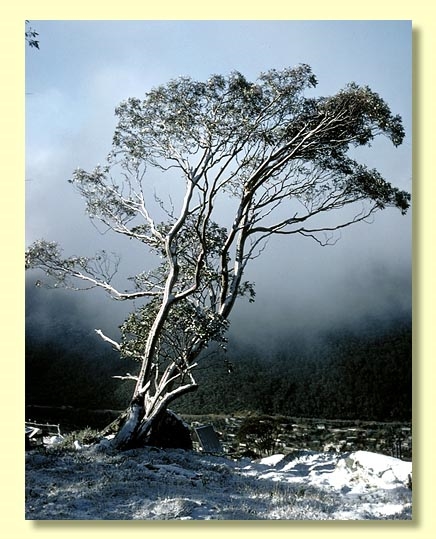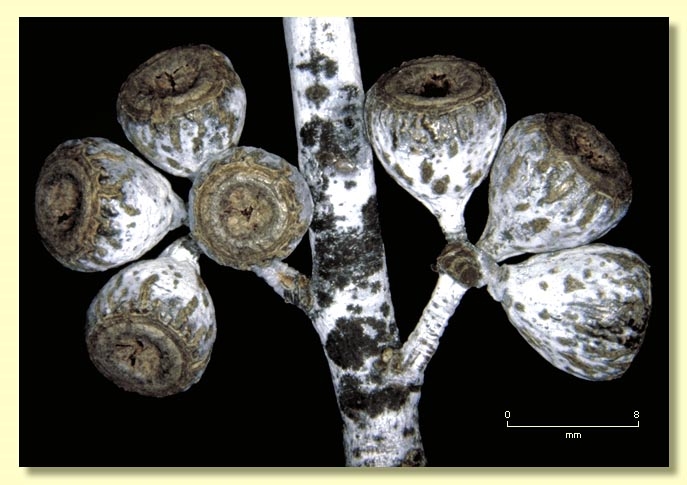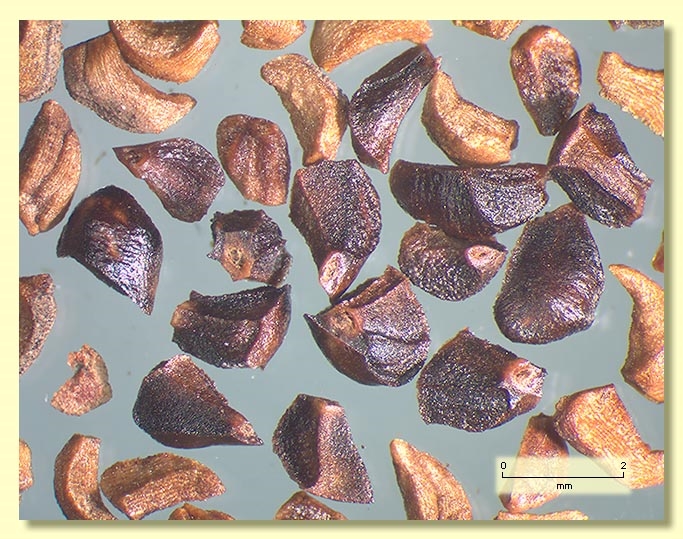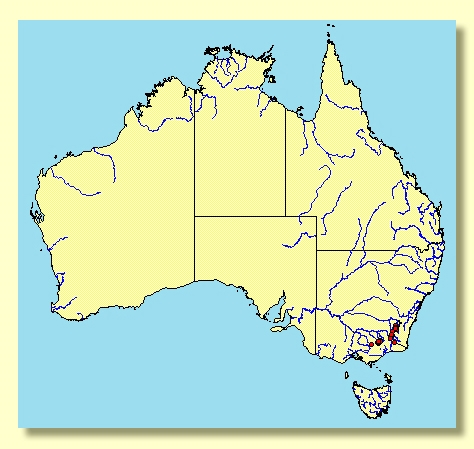Euclid - Online edition
Eucalyptus pauciflora subsp. niphophila
Eucalyptus | Eucalyptus | Cineraceae | Pauciflorae
Eucalyptus niphophila Maiden & Blakely, Crit. Revis. Eucalyptus 8: 34 (1929); E. pauciflora var. alpina Ewart, Fl. Victoria 837 (1930). T: Pretty Point, Mt Kosciuszko, NSW, Jan. 1899, J.H.Maiden & W.Forsyth s.n.; holo: NSW.
Eucalyptus coriacea var. alpina Benth., Flora Australiensis 3: 201 (1867). T: Mountains on the Macalister River, F.Mueller; n.v.
Bark smooth, white to cream and grey, with patches of yellow and pink, often with scribbles; branchlets glaucous.
Juvenile growth (coppice or field seedlings to 50 cm): stem rounded in cross-section, glaucous, slightly warty or smooth; juvenile leaves opposite for 4 to 10 nodes then alternate, petiolate, ovate, 2.5–7.5 cm long, (1.2)2–3.5 cm wide, base truncate to rounded or tapering to petiole, dull, blue-green to glaucous.
Adult leaves alternate, petiole 1–2 cm long; blade lanceolate to ovate to falcate or elliptical, 5–10 cm long, 1.2–3 cm wide, base oblique or tapering to petiole, glossy, green to blue-green, parallel-veined, sparsely to moderately reticulate, intramarginal vein parallel to and well removed from margin, oil glands island.
Inflorescence axillary unbranched, peduncles 0.5–1 cm long, buds 9 to ?15 per umbel, usually shortly pedicellate (pedicels to 0.4 cm long). Mature buds obovoid or clavate, 0.4–0.8 cm long, 0.3–0.6 cm wide, green to red under white wax, smooth or warty, scar absent, operculum rounded to beaked, stamens inflexed, anthers reniform to cordate, versatile, dorsifixed, dehiscing by confluent slits (usually), style short or long, stigma blunt or tapered, locules usually 3 each with 2 or 4 vertical ovule rows. Flowers white.
Fruit sessile or on pedicels to 0.3 cm long, cup-shaped to obconical or hemispherical, 0.6–1 cm long, 0.6–1 cm wide, glaucous, disc level or descending, valves usually 3, near rim level or enclosed.
Seeds black, or brown, 1.5–2 mm long, pyramidal or obliquely pyramidal, dorsal surface smooth, hilum terminal.
Cultivated seedlings (measured at ca node 10): cotyledons reniform; stems rounded in cross-section, glaucous; leaves shortly petiolate, elliptic and opposite for 5 to 6 pairs then alternate, ovate to narrowly so, 5–7 cm long, 2–4 cm wide, base truncate to rounded or tapering, margin entire, apex pointed, dull, blue-grey to grey-green or glaucous.
Flowering has been recorded in December, January and February.
Eucalyptus pauciflora is a species with mallee or small to tall tree habit, widespread from the far south-east of Queensland (represented there by a single population near Stanthorpe), through the tablelands and alps of New South Wales but also subcoastal west of Bega, the highlands and southern Victoria, central and north-eastern Tasmania, and a single population east of Mt Gambier in the south-east of South Australia.
E. pauciflora belongs to the blue-leaved ash group of eucalypts because of the characteristic alternate, broadly ovate, pendulous, petiolate, bluish to glaucous juvenile leaves. It differs from all other ashes by the parallel side-veins of the adult leaves, which are glossy, green to olive green and highly glandular. Buds of E. pauciflora are usually in nines or more and fruits are cupular or obconical or, less commonly, hemispherical, always with a thick rim. Its closest relative is E. lacrimans, a snow-gum of weeping habit and sparse crown, that is found usually in small, pure stands in the Yarrangobilly – Long Plain area of Kosciuszko National Park, New South Wales. A slender mallee form of snow-gum, E. gregsoniana, occurs disjunctly in the Lithgow – Bell – Newnes Junction area and in the south in the Budawang – Nerriga – Morton National Park area, also in New South Wales. Apart from the habit, E. gregsoniana differs from other snow gums by the narrower juvenile leaves.
There are five subspecies:
E. pauciflora subsp. pauciflora
Occurs over the whole geographic range of the species from Queensland, New South Wales, Victoria, Tasmania and South Australia, and almost the whole altitudinal range from coastal lowlands in south Gippsland, Victoria, to all but the highest altitudes in the Australian Alps. It can be a tree or robust mallee, often with waxy branchlets and hemispherical to obconical fruit to 1 cm wide. E. pauciflora subsp. parvifructa from the Major Mitchell Plateau in the Grampians of Victoria is included here in synonymy. The dimensions of its leaves, buds and fruit overlap almost entirely with those of the very variable subsp. pauciflora.
E. pauciflora subsp. acerina
Occurs only on the Baw Baw plateau of eastern Victoria, e.g. Mt Erica, Mt St Gwinear and Mt Baw Baw and the nearby Mt Useful. Subsp. acerina differs from subsp. pauciflora in the complete lack of glaucescence, and very glossy adult leaves.
E. pauciflora subsp. debeuzevillei
Occurs on highest peaks south from Mt Franklin and Mt McKeahnie in the Australian Capital Territory to the Jounama Range near Yarrangobilly, and Yaouk Peak area, both in south-eastern New South Wales. Subsp. debeuzevillei differs from other subspecies by the strongly angular mature buds. Note that immature buds of the other subspecies may be angular at first but rounded at maturity. The fruits of subsp. debeuzevillei may have the traces of these angles on the surface but are usually well-rounded.
E. pauciflora subsp. hedraia
Restricted to the Falls Creek and Mount Bogong area of eastern Victoria. Subsp. hedraia differs by the larger, glaucous, sessile buds and broadly hemispherical fruit to 1–1.5 cm wide.
E. pauciflora subsp. niphophila
Restricted to the highest altitudes suitable for tree growth in the Snowy Mountains of New South Wales, e.g. many places in the Kosciuszko National Park, extending to Bimberi in the Australian Capital Territory, and in Victoria on Mt Hotham, Mt Bogong and the Bogong High Plains, Mt Torbreck and Mt Wellington. It is reduced to a twisted, dense stunted tree, and differs from other subspecies by the more delicate, pedicellate buds and smaller leaves. Branchlets, buds and fruits are usually glaucous.
It is not uncommon to find specimens that do not precisely match one of the above subspecies; for example, plants otherwise like subsp. pauciflora but with minimal glaucescence are common on Mt Skene, Bennison High Pains and Lake Mountain and may approach subsp. acerina. Similarly in the Kiandra area of Kosciuszko National Park plants may have mature buds slightly angled but much less prominently so than does subsp. debeuzevillei. On Mt Wellington in Victoria high altitude plants with the general appearance of subsp. niphophila but with little wax show some traits of subsp. acerina.
Eucalyptus pauciflora belongs in subgenus Eucalyptus section Cineraceae series Pauciflorae having the following characters, cotyledons reniform, juvenile leaves alternate, bluish to glaucous, adult leaves with side-veins parallel to the midrib, single axillary inflorescences with buds in clusters of nine to 15, buds with single operculum, inflexed stamens with reniform anthers, ovules in two rows (very rarely four rows in highest altitude plants in Kosciuszko National Park), and seeds more or less pyramidal. The species in series Pauciflorae are E. pauciflora, E. lacrimans and E. gregsoniana and their differences are discussed above.
On the Mount Buffalo plateau in Victoria another snow gum species occurs, E. mitchelliana, which on bark and adult leaf characters is easily confused with E. pauciflora. Buds of E. mitchelliana are distinctive forming tight "stellate" clusters, and are narrowly fusiform with pointy opercula.
Eucalyptus pauciflora: Latin pauci-, few and florus, flowered, of the inflorescences, a misnomer.
subsp. niphophila: Greek niphophilos, snow-loving, referring to the alpine habitat.











